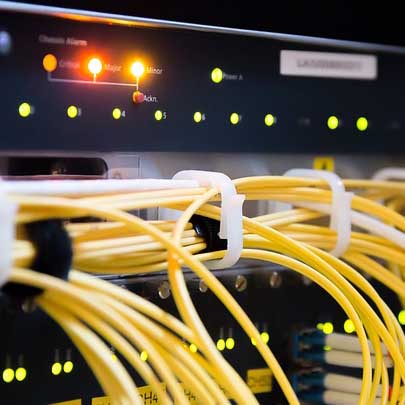
Verify Backups. This is perhaps the single most important server maintenance task. Depending on the volume of data the organization generates per day, backups should be tested daily or weekly. For mission-critical systems, routine testing can go as far as running actual test recovery. If you are only backing up part of and not the entire system, ensure that any newly introduced applications have been risk rated and, if applicable, included in the backup routine.
Physically Clean Your Server. Even if you keep your server in a closed cabinet, your server can collect direct and dust. Good quality servers generally contain fans to keep air moving, but that doesn’t prevent dust from collecting. Be sure to remove and clean all the filters if your server case has them.
Monitor Disk Usage. If disk usage is regularly approaching or exceeding 90 percent of overall capacity, you need to either add more disk space or clean it up. Such high disk usage gradually degrades system performance and increases the likelihood of data corruption. Delete old emails, logs, installation files and software that is no longer required.
Update the OS. Hackers routinely scan enterprise systems for vulnerabilities to know which systems will be easiest to penetrate. This is why server OS updates are released fairly frequently. That can make staying current quite difficult, especially if you are wholly reliant on manually installing the updates. For this reason, an automated patch management system is handy. An automated system will inform you when a new patch is available and allow you to even specify automatic updates. However, if you cannot automate the patching process, develop a manual schedule. Ideally, you should update newer OS versions weekly (because they are likely to have more bugs) and do the same monthly for older versions.
Update Web Applications. Web apps have been the doorway for the majority of larger scale security breaches. Since they are internet-facing, websites and web apps are more prone to cyberattacks. Hackers will identify and exploit vulnerabilities to gain a foothold in the organization’s network. From there, they can install malware and conduct reconnaissance to pick up glaring opportunities they can take advantage of. This is why you should prioritize web app updates. Where possible, check for new patches daily and apply high-priority updates as soon as is practically possible.
Look Out for Hardware Errors. You may want to review the logs for any signs of hardware problems. Overheating notices, disk read errors, network failures could be early indicators of potential hardware failure. These are rare but worth a look, especially if the system has not been working within normal ranges. Check with your IT department or your service provider as this step may often require some technical ability or a professional to review the logs properly.
Check Resource Utilization. Review network, server RAM, CPU and disk utilization. If the system is frequently nearing or exceeding its optimal operating limits, you need to start the process of increasing capacity or completely replacing the equipment. You can keep track of utilization using the default tools available on Linux and Windows servers.
Physically Inspect Equipment. Perhaps one of the network cables is coming loose or the server room is getting congested, making the servers overheat. Inspecting critical infrastructure should be part of an administrator’s morning routine.
Monitor Server Room Humidity and Temperature. Humidity and temperature can affect server and network performance. In the short term, it slows down performance. In the long term, it shrinks equipment service life. For example, running your servers at temperatures above the specified standard can cause regular sluggish performance and occasional data corruption. Similarly, if the server room has above optimal humidity, the resulting condensation can cause a short circuit or equipment corrosion.
Review User Accounts. If you have had staff changes, client cancellations or other user changes, you will want to remove these users from your system. Storing old sites and users is both a security and legal risk. Depending on your service contracts, you may not have the right to retain a client’s data after they have terminated services.
Run an Antivirus Scan. The primary purpose of antivirus software is to prevent infection. Usually, users will be notified when they try to introduce an infected file. However, every so often, some files may go undetected. In addition, the virus definitions are regularly being updated so files that were okay a few weeks earlier may be flagged as infected. Schedule a detailed antivirus scan to detect and remove malware. As this can be a strain on system resources, the scan should be scheduled for off-peak hours.
Check System Security. Always assess the state of server, database and network security by using remote auditing tools. Some IT departments overly rely on internal IT auditors under the assumption that identifying system vulnerabilities is an audit function. This can be a costly miscalculation, given that IT auditors may not have the time to carry out system checks frequently.
Change Passwords. System, database and network administrators are privy to the most powerful user accounts in the organization. In the wrong hands, these super user accounts can be used to facilitate actions with potential negative consequences. Passwords should be changed at least every six months.
Despite significant advances in redundancy and performance features in modern servers, growing workload and reliability expectations can take a toll on technology. The more robust your maintenance regime, the less downtime you are likely to experience and the longer your technology infrastructure will last.
If you have any questions regarding server maintenance task(s), our team of experts are here to help. Contact us at 978-562-6077, or by email at ITExperts@Bryley.com.
References:
securityboulevard.com
Maintenance Tasks – docs.microsoft.com
Maintenance Tasks For SQL Server – mssqltips.com
Maintenance Tasks – ibm.com
Windows Server Maintenance Checklist – anturis.com
Monthly And Yearly Maintenance Tasks – redmondmag.com
Virtual Server Maintenance Tasks We All Forget – techtarget.com
Verify Backup – handybackup.net
storagecraft.com







